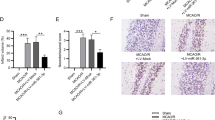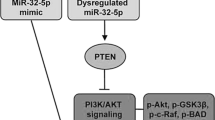Abstract
Recently, the study of microRNA expression profile has shown that miR-224 was implicated in neuron injury, but the mechanism of miR-224 on regulating neuronal apoptosis is completely unclear until now. Therefore, the current study aims to illuminate the miR-224 and its target gene on the modulation of neuronal cell apoptosis induced by ischemic injury. In this study, we used oxygen/glucose deprivation (OGD)-induced human-derived HCN-2 cells to establish the model of cerebral ischemia injury. We found that miR-224 was upregulated in injured cells (human brain cortical neuron). Using bioinformatics analyses, we found that miR-224 targeted the 3′UTR of spastic paraplegia 7 (SPG7) and the miR-224 inhibitor promoted expression of SPG7 and promoter activity of SPG7 3′UTR. In addition, we further found that miR-224 inhibitor enhanced interaction SPG7 with mitochondrial voltage-dependent anion channel (VDAC1) detected by co-immunoprecipitation in injured cells. The knockdown of SPG7 reduced mitochondrial membrane potential and caused higher mitochondrial calcium retention in injured cells. Knockdown of SPG7 inhibits expression of nicotinic acetylcholine receptor. Besides, the miR-224 inhibitor reduced neuronal cell apoptosis was increased by knockdown of either SPG7 or VDAC1. Overall, miR-224 inhibitor may prevent neuronal cell apoptosis by targeting SPG7 3′UTR and promote interaction SPG7 with VDAC1 after cerebral ischemia. Downregulation of SPG7 induces VDAC1 to form mitochondria permeability transition pore probably by inhibiting expression of nicotinic acetylcholine receptor, resulting in mitochondrial membrane depolarization and higher mitochondrial calcium retention.




Similar content being viewed by others
References
Abudara V, Jiang RG, Eyzaguirre C (2002) Behavior of junction channels between rat glomus cells during normoxia and hypoxia. J Neurophysiol 88:639–649
Brennan-Minnella AM, Won SJ, Swanson RA (2015) NADPH oxidase-2: linking glucose, acidosis, and excitotoxicity in stroke. Antioxid Redox Signal 22:161–174
Broughton BR, Reutens DC, Sobey CG (2009) Apoptotic mechanisms after cerebral ischemia. Stroke 40:e331–e339
Casari G, De Fusco M, Ciarmatori S, Zeviani M, Mora M, Fernandez P, De Michele G, Filla A, Cocozza S, Marconi R, et al. (1998) Spastic paraplegia and OXPHOS impairment caused by mutations in paraplegin, a nuclear-encoded mitochondrial metalloprotease. Cell 93:973–983
Chi W, Meng F, Li Y, Wang Q, Wang G, Han S, Wang P, Li J (2014) Downregulation of miRNA-134 protects neural cells against ischemic injury in N2 A cells and mouse brain with ischemic stroke by targeting HSPA12B. Neuroscience 277:111–122
Deng X, Zhong Y, Gu L, Shen W, Guo J (2013) MiR-21 involve in ERK-mediated upregulation of MMP9 in the rat hippocampus following cerebral ischemia. Brain Res Bull 94:56–62
Dugan LL, Sensi SL, Canzoniero LM, Handran SD, Rothman SM, Lin TS, Goldberg MP, Choi DW (1995) Mitochondrial production of reactive oxygen species in cortical neurons following exposure to N-methyl-D-aspartate. J Neurosci 15:6377–6388
Guo L, Yang X, Lin X, Lin Y, Shen L, Nie Q, Ren L, Guo Q, Que S, Qiu Y (2015) Silencing of Id2 attenuates hypoxia/ischemia-induced neuronal injury via inhibition of neuronal apoptosis. Behav Brain Res 292:528–536
Hoffman NE, Chandramoorthy HC, Shamugapriya S, Zhang X, Rajan S, Mallilankaraman K, Gandhirajan RK, Vagnozzi RJ, Ferrer LM, Sreekrishnanilayam K, et al. (2013) MICU1 motifs define mitochondrial calcium uniporter binding and activity. Cell Rep 5:1576–1588
Huang J, Upadhyay UM, Tamargo RJ (2006) Inflammation in stroke and focal cerebral ischemia. Surg Neurol 66:232–245
Keinan N, Tyomkin D, Shoshan-Barmatz V (2010) Oligomerization of the mitochondrial protein voltage-dependent anion channel is coupled to the induction of apoptosis. Mol Cell Biol 30:5698–5709
Kondo T, Reaume AG, Huang TT, Carlson E, Murakami K, Chen SF, Hoffman EK, Scott RW, Epstein CJ, Chan PH (1997) Reduction of CuZn-superoxide dismutase activity exacerbates neuronal cell injury and edema formation after transient focal cerebral ischemia. J Neurosci 17:4180–4189
Lanz J, Brophy JM, Therrien J, Kaouache M, Guo L, Marelli AJ (2015) Stroke in adults with congenital heart disease: incidence, cumulative risk, and predictors. Circulation 132:2385–2394
Li F, Han SS, Tatlisumak T, Liu KF, Garcia JH, Sotak CH, Fisher M (1999) Reversal of acute apparent diffusion coefficient abnormalities and delayed neuronal death following transient focal cerebral ischemia in rats. Ann Neurol 46:333–342
Li Q, Ding C, Chen C, Zhang Z, Xiao H, Xie F, Lei L, Chen Y, Mao B, Jiang M, et al. (2014) miR-224 promotion of cell migration and invasion by targeting Homeobox D 10 gene in human hepatocellular carcinoma. J Gastroenterol Hepatol 29:835–842
Liang M, Yao G, Yin M, Lu M, Tian H, Liu L, Lian J, Huang X, Sun F (2013) Transcriptional cooperation between p53 and NF-kappaB p65 regulates microRNA-224 transcription in mouse ovarian granulosa cells. Mol Cell Endocrinol 370:119–129
Lin, L, Lu B, Yu J, Liu W, Zhou A (2015) Serum miR-224 as a biomarker for detection of hepatocellular carcinoma at early stage. Clin Res Hepatol Gastroenterol. doi:10.1016/j.clinre.2015.11.005
Lucas SM, Rothwell NJ, Gibson RM (2006) The role of inflammation in CNS injury and disease. Br J Pharmacol 147(Suppl 1):S232–S240
Lykhmus O, Gergalova G, Koval L, Zhmak M, Komisarenko S, Skok M (2014) Mitochondria express several nicotinic acetylcholine receptor subtypes to control various pathways of apoptosis induction. Int J Biochem Cell Biol 53:246–252
Mencia N, Selga E, Noe V, Ciudad CJ (2011) Underexpression of miR-224 in methotrexate resistant human colon cancer cells. Biochem Pharmacol 82:1572–1582
Murakami K, Kondo T, Kawase M, Li Y, Sato S, Chen SF, Chan PH (1998) Mitochondrial susceptibility to oxidative stress exacerbates cerebral infarction that follows permanent focal cerebral ischemia in mutant mice with manganese superoxide dismutase deficiency. J Neurosci 18:205–213
Ni J, Wang X, Chen S, Liu H, Wang Y, Xu X, Cheng J, Jia J, Zhen X (2015) MicroRNA let-7c-5p protects against cerebral ischemia injury via mechanisms involving the inhibition of microglia activation. Brain Behav Immun 49:75–85
Scisciani C, Vossio S, Guerrieri F, Schinzari V, De Iaco R, D’Onorio de Meo P, Cervello M, Montalto G, Pollicino T, Raimondo G, et al. (2012) Transcriptional regulation of miR-224 upregulated in human HCCs by NFkappaB inflammatory pathways. J Hepatol 56:855–861
Shanmughapriya S, Rajan S, Hoffman NE, Higgins AM, Tomar D, Nemani N, Hines KJ, Smith DJ, Eguchi A, Vallem S, et al. (2015) SPG7 is an essential and conserved component of the mitochondrial permeability transition pore. Mol Cell 60:47–62
Sottocasa GL, Kuylenstierna B, Ernster L, Bergstrand A (1967) An electron-transport system associated with the outer membrane of liver mitochondria. A biochemical and morphological study. J Cell Biol 32:415–438
Tao J, Liu W, Shang G, Zheng Y, Huang J, Lin R, Chen L (2015) MiR-207/352 regulate lysosomal-associated membrane proteins and enzymes following ischemic stroke. Neuroscience 305:1–14
Wang Y, Lee CG (2011) Role of miR-224 in hepatocellular carcinoma: a tool for possible therapeutic intervention? Epigenomics 3:235–243
Wang M, Deng X, Ying Q, Jin T, Li M, Liang C (2015) MicroRNA-224 targets ERG2 and contributes to malignant progressions of meningioma. Biochem Biophys Res Commun 460:354–361
Wilke K, Gaul R, Klauck SM, Poustka A (1997) A gene in human chromosome band Xq28 (GABRE) defines a putative new subunit class of the GABAA neurotransmitter receptor. Genomics 45:1–10
Yao G, Yin M, Lian J, Tian H, Liu L, Li X, Sun F (2010) MicroRNA-224 is involved in transforming growth factor-beta-mediated mouse granulosa cell proliferation and granulosa cell function by targeting Smad4. Mol Endocrinol 24:540–551
Yu L, Zhang J, Guo X, Li Z, Zhang P (2014) MicroRNA-224 upregulation and AKT activation synergistically predict poor prognosis in patients with hepatocellular carcinoma. Cancer Epidemiol 38:408–413
Zhang Y, Takahashi S, Tasaka A, Yoshima T, Ochi H, Chayama K (2013) Involvement of microRNA-224 in cell proliferation, migration, invasion, and anti-apoptosis in hepatocellular carcinoma. J Gastroenterol Hepatol 28:565–575
Acknowledgments
None
Author information
Authors and Affiliations
Corresponding author
Ethics declarations
Conflicts of Interest
The authors declare that they have no conflicts of interest.
Rights and permissions
About this article
Cite this article
Fu, F., Wu, D. & Qian, C. The MicroRNA-224 Inhibitor Prevents Neuronal Apoptosis via Targeting Spastic Paraplegia 7 After Cerebral Ischemia. J Mol Neurosci 59, 421–429 (2016). https://doi.org/10.1007/s12031-016-0769-9
Received:
Accepted:
Published:
Issue Date:
DOI: https://doi.org/10.1007/s12031-016-0769-9




